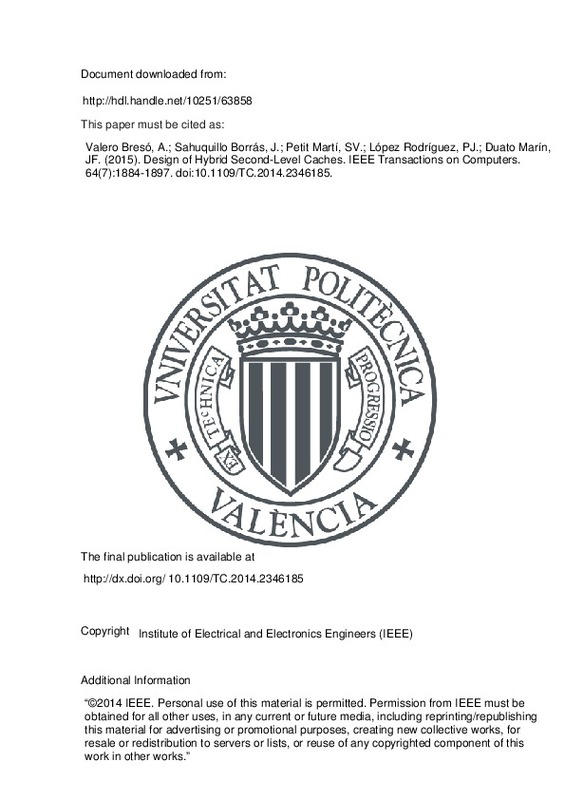Valero Bresó, A.; Sahuquillo Borrás, J.; Petit Martí, SV.; López Rodríguez, PJ.; Duato Marín, JF. (2015). Design of Hybrid Second-Level Caches. IEEE Transactions on Computers. 64(7):1884-1897. https://doi.org/10.1109/TC.2014.2346185
Por favor, use este identificador para citar o enlazar este ítem: http://hdl.handle.net/10251/63858
|
Título:
|
Design of Hybrid Second-Level Caches
|
|
Autor:
|
 Valero Bresó, Alejandro
Valero Bresó, Alejandro

 Sahuquillo Borrás, Julio
Sahuquillo Borrás, Julio

 Petit Martí, Salvador Vicente
Petit Martí, Salvador Vicente

 López Rodríguez, Pedro Juan
Duato Marín, José Francisco
López Rodríguez, Pedro Juan
Duato Marín, José Francisco
|
|
Entidad UPV:
|
Universitat Politècnica de València. Departamento de Informática de Sistemas y Computadores - Departament d'Informàtica de Sistemes i Computadors
|
|
Fecha difusión:
|
|
|
Resumen:
|
In recent years, embedded dynamic random-access memory (eDRAM) technology has been implemented in last-level
caches due to its low leakage energy consumption and high density. However, the fact that eDRAM presents slower ...[+]
In recent years, embedded dynamic random-access memory (eDRAM) technology has been implemented in last-level
caches due to its low leakage energy consumption and high density. However, the fact that eDRAM presents slower access time than
static RAM (SRAM) technology has prevented its inclusion in higher levels of the cache hierarchy. This paper proposes to mingle
SRAM and eDRAM banks within the data array of second-level (L2) caches. The main goal is to achieve the best trade-off among
performance, energy, and area. To this end, two main directions have been followed. First, this paper explores the optimal percentage
of banks for each technology. Second, the cache controller is redesigned to deal with performance and energy. Performance is
addressed by keeping the most likely accessed blocks in fast SRAM banks. In addition, energy savings are further enhanced by
avoiding unnecessary destructive reads of eDRAM blocks. Experimental results show that, compared to a conventional SRAM L2
cache, a hybrid approach requiring similar or even lower area speedups the performance on average by 5.9 percent, while the total
energy savings are by 32 percent. For a 45 nm technology node, the energy-delay-area product confirms that a hybrid cache is a better
design than the conventional SRAM cache regardless of the number of eDRAM banks, and also better than a conventional eDRAM
cache when the number of SRAM banks is an eighth of the total number of cache banks
[-]
|
|
Palabras clave:
|
Cache memories
,
eDRAM
,
Energy-aware systems
,
Hybrid systems
,
SRAM
|
|
Derechos de uso:
|
Reserva de todos los derechos
|
|
Fuente:
|
IEEE Transactions on Computers. (issn:
0018-9340
)
|
|
DOI:
|
10.1109/TC.2014.2346185
|
|
Editorial:
|
Institute of Electrical and Electronics Engineers (IEEE)
|
|
Versión del editor:
|
http://dx.doi.org/ 10.1109/TC.2014.2346185
|
|
Código del Proyecto:
|
info:eu-repo/grantAgreement/MINECO//TIN2012-38341-C04-01/ES/MEJORA DE LA ARQUITECTURA DE SERVIDORES, SERVICIOS Y APLICACIONES/
|
|
Descripción:
|
“©2014 IEEE. Personal use of this material is permitted. Permission from IEEE must be obtained for all other uses, in any current or future media, including reprinting/republishing this material for advertising or promotional purposes, creating new collective works, for resale or redistribution to servers or lists, or reuse of any copyrighted component of this work in other works.”
|
|
Agradecimientos:
|
This work was supported by the Spanish Ministerio de Economia y Competitividad (MINECO) and FEDER funds under Grant TIN2012-38341-C04-01. Additionally, it was also supported by the Intel Early Career Honor Programme Award ...[+]
This work was supported by the Spanish Ministerio de Economia y Competitividad (MINECO) and FEDER funds under Grant TIN2012-38341-C04-01. Additionally, it was also supported by the Intel Early Career Honor Programme Award and the Intel Doctoral Student Honor Programme Award. Part of this work was done while Alejandro Valero was a visiting researcher with the Northeastern University Computer Architecture Research laboratory conducted by Prof. David R. Kaeli, Department of Electrical and Computer Engineering, Northeastern University, Boston, MA, USA.
[-]
|
|
Tipo:
|
Artículo
|







![[Cerrado]](/themes/UPV/images/candado.png)


